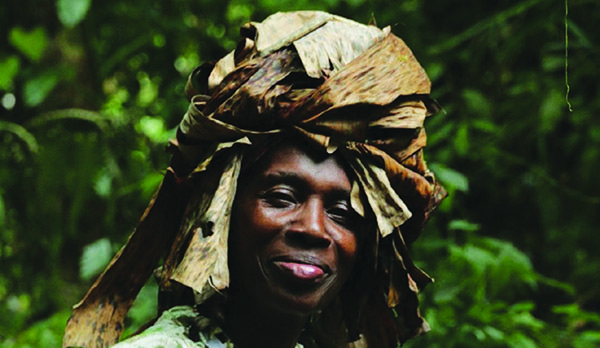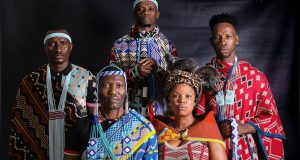Photo above: Gloria Simms plays the lead role as Queen Nanny. Photo courtesy of Roy Anderson.
A Runaway History Of A Revered Jamaican Hero
By Kirk Moss
PRIDE Film Reviewer
Deep in the thorny, mountainous and gully-side history of Jamaican society, in its complex and tough pages of struggle, resistance and earth-moving feats, emerges figures of legendary prominence.
Jamaicans world-wide have always upheld a strong sense of pride, dignity and integrity towards their cultural and historic roots, which invigorates their determination, staunch work-ethic and a cemented motivation for excellence in their endeavors.
This effort was clearly shown, to a packed audience at Innis Town Hall on a rainy, late Sunday September afternoon, at the test screening of Roy Anderson’s Queen Nanny: Legendary Maroon Chieftainess, which chiefly portrays her in the utmost noble of lights.
Anderson, a proud Maroon descendant and director of Akwantu: the Journey (Filmworks, 2012), is on a mission to not only pay homage to his great relative, but, more importantly, to spread Nanny’s story beyond the Jamaican shorelines during our city’s thick film festival heat-wave, including TIFF and Caribbean Tales.
Without question, Queen Nanny is a tale of courage, bravery and rebellion from the onslaught of forceful systematic European oppression, with lethal, tragic and blood-shedding consequences.
The institution of slavery killed, murdered, torched and traumatized over 100 million African lives for over 500 years.
Anderson’s story provides a context of battle and warfare between Maroon African Jamaicans and their land-owning, power-thirsty European counterparts. Slavery was well into its second century when Nanny, a married woman, of Gold-Coast Ghanaian Ashante decent, arrived on the Jamaican battlefield.
Through exclusive footage of Ashante spiritual rituals and those of Jamaican Maroons up in their mountain-top communities, we get a glimpse of her cultural upbringing, grounded within an unshakable spiritual foundation, civilization building leaders and wisdom-bearing elders.
The film stipulates she came from a Ghanaian matriarchal lineage; however, the story does not grapple with the deeper questions of African Jamaican patriarchy within this time period. Thus, a broader discussion of gender power-dynamics within Jamaican society is certainly imperative towards furthering our notion of personhood in contemporary Jamaica, where Portia Simpson, like Nanny to the British and Bolt to Gatlin, out-paced the United States, and most Western nations, in electing a female head of state.
Therefore, a richer dialogue must emerge from this film in explaining how Nanny, under European patriarchal Jamaica and operating within African-Jamaican patriarchal society becomes a leader of men in the brutal, blood-sport of war, when women were not only seen but known to be, in the western imagination, nurturers and the weaker sex.
One can argue, that African Jamaican patriarchy, for centuries, has revered feminine leadership and governing qualities, but we need to further query this point to avoid the regressive “strong black woman” stereotypical archetype.
Nonetheless, Nanny’s story urges us to critically address what it meant for African Jamaican women to assert their femininity, not in a countering or confrontational context towards African Jamaican men, but rather in the fullness of nation-building, cultural and human survival, in establishing a legacy rich in gender consciousness for unseen generations to embrace.
There is something to be treasured and cherished in realizing how Continental and Diasporic African societies, with their imperfections, nourished and strengthened the full potential and human capacity of both men and women.
Remember Aminata from the The Book of Negros and how she was raised, her parental values and prodigious traditions?
Now, imagine these two gendered entities with their immense social, political and cultural capital harmoniously existing for the betterment of each other, working tirelessly to enhance their life of endless possibilities, piercing triumphantly, through circumstantial forces.
In its effort to champion Nanny’s gleaming skills in fighting the British, the film refuses to underscore her shortcoming and failures or question how she rose to such a consecrated and usually male-reserved position.

Director, Roy Anderson, doing a cameo appearance as a slave soldier in Queen Nanny. Photo courtesy of Roy Anderson.
Without this conversation, her story begins to drift into fairytale, mysticism, and folklore, instead of the accomplished hero we’ve come to know. Her story sounds quite unbelievable, similar to many other tales of tricksters like Anansi buried but Omni-present within the oral tradition of Jamaican culture. It begs the question of how survival tactics were used in dire and desperate times especially on a battlefield where freedom, liberation and independence was at stake.
We must ponder what the collective Maroon community was intending when they decided to elect Nanny as a military leader; what resistance did she endure from both genders and her own husband?
Maybe, because women were seen as the “weaker” gender, precisely in the European imagination, it was tactically advantageous for her brilliance to shine as her gender was under-estimated by the Europeans, which the Maroon society, exquisitely designed and unequivocally understood, as a strategic warfare move.
If there is never smoke without some kind of fire, then we must challenge and put forward various explanations in drawing historic conclusions, in furthering our present-day understandings without succumbing to the pitfalls of ‘perfect’ figures and inconclusive representations of lives and times past.
Furthermore, the story of Jamaican uprisings against slavery were varied and tumultuously complicated, as Maroons who fought for their ‘own’ communal freedom, did not always see the value of a collective Jamaican effort against slavery.
Instead, some Maroons, and specifically those within the Portland region, worked for the Europeans to capture and killed African Jamaican’s who rebelled against slavery. The legendary Jamaican freedom fighter and national hero Paul Bogle is a perfect example of Maroons colluding with the British to squash Bogle’s movement towards National freedom, independence and liberation, in the end capturing and hanging Bogle to death.
Thus, the narrative of Nanny and Jamaican national independence and greater freedom is layered with contradictions and its imperative for us to not settle for simplistic short-sightedness in retelling historical tales.
We’ve witnessed a striking shift in Black Diasporic Film-making from the single flawless hero stories and figures, like Martin Lurther King Jr., who many were led to believe was a saint loaned from the skies above, to more humanizing and realistic depictions of events and leaders.
Thus, in the film Selma, we come to see King as a man, husband, leader and human rights-champion who had numerous disagreeing arguments with fellow leaders, made countless personal and social missteps, working not alone with angel-guidance, but rather with a collective communal organizing force, determined to withstand the blows of systematic oppression, together.
Similarly, The Book of Negroes television series illustrates the tough tooth and nail, and sometimes antagonistic relations between African Americans, especially during the American Civil War, where Black people were split between two empires and unfortunately had to fight each other for crumbs of so-called freedom.
This is another example that disrupts the tidy, clean and sanitized notion of African Peoples history in the western world, which is sadly lacking in Anderson’s story of Nanny. His tale is void of balance regarding the various forces, communities and stakeholders within Jamaican society at the juncture in which Nanny arises to battlefield notoriety.
Thus, instead of shining a new sensibility towards the seeded concerns of collective struggle leading to community triumph with numerous heroes and she-roes, the film solely highlights Nanny in all her glory, bravery and almost masculine character.
One folklore explained her male-like toughness, by telling the story of her using her posterior to stop British bullets and return fire with the same bullets. Even Superwoman, who made no money, didn’t posses those powers.
But such aggrandizing portrayals damage the integrity of Nanny’s identity and truth-telling capacity this film carries in its narrative.
With its potential to unearth new historic exemplars, stories and culturally-inspiring experiences of African Jamaicans and showing direction to connecting their history to their African-Continental ancestors, even half of this story is certainly necessary to be told.
Kirk Moss is a history teacher, journalist, curriculum writer, public speaker and forum facilitator.
 Pride News Canada's Leader In African Canadian & Caribbean News, Views & Lifestyle
Pride News Canada's Leader In African Canadian & Caribbean News, Views & Lifestyle





